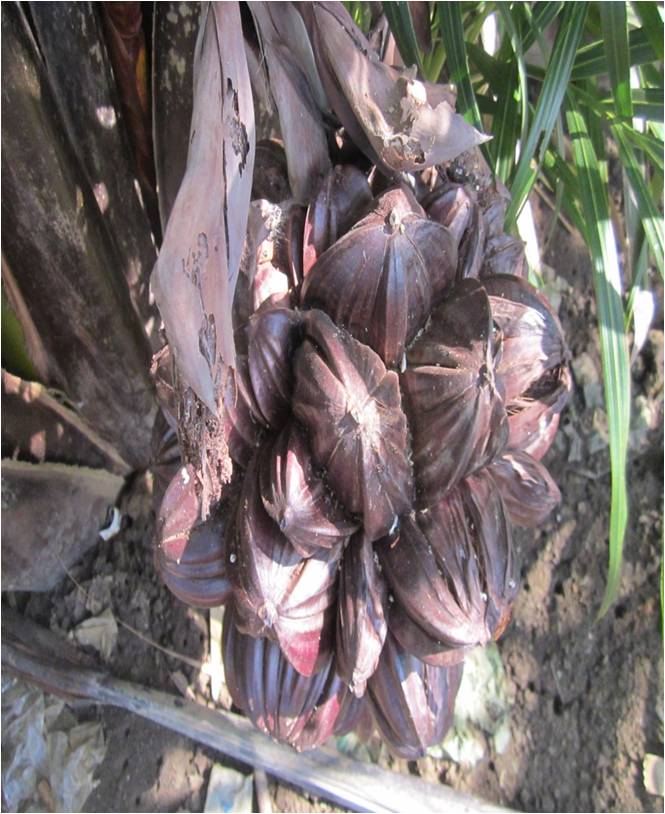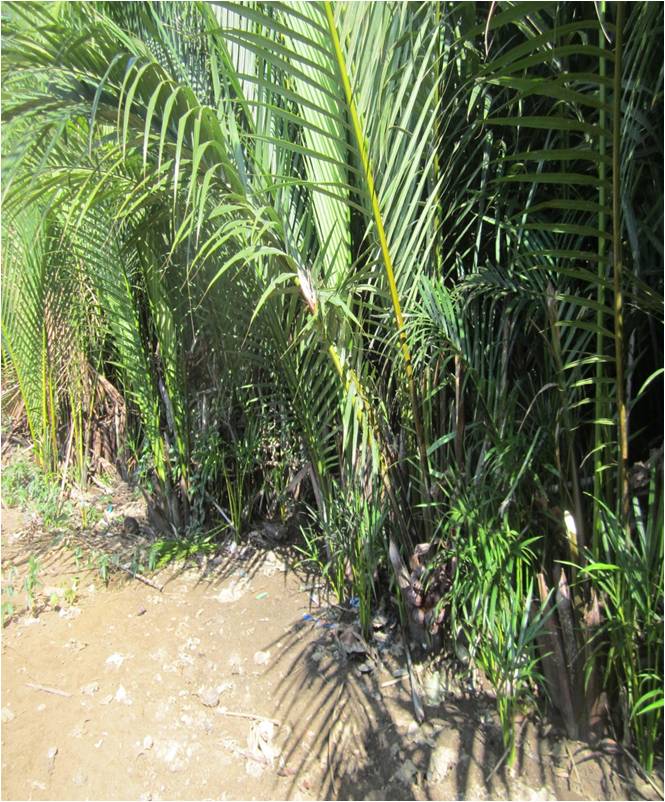
The Nipa Nuts
Nipa oil, unknown in the chemistry handbooks, had been characterized in the Philippines and Indonesia. These studies however, do not agree with each other as shown on their results in Table 1.
Table 1 Discrepancies on the characteristic studies on Nipa oil
| Tabinas’s Study (1987) [1] | Hamzah’s Study (2011) [2] | |
| Percentage oil | 2.87 | 27.4 |
| Viscosity | NA | 76.79 |
| Iodine value | 88.94 | 25.55 |
| Saponification value | 195.22 | 32.86 |
| Specific gravity | 0.9153 | NA |
| Refractive index | 1.4730 | NA |
| Melting point | 23.7oC | NA |
| Note: NA means not analysed | ||
What could have been the cause/s of the disagreement in the results? Hopefully, the next characterization study on nipa oil will answer this.
Vegetable fats and oils are characterized in Lange’s Hansbook of Chemistry as to physical and chemical properties that include melting point, refractive index, specific gravity, saponification value, iodine value, and acid value.[3]

The Nipa Plant
To date, there is no spectroscopical studies conducted on nipa oil (in order to characterize its glyceride contents and structures). However, an attempt to characterize the glyceride contents of nipa oil was done through approximation analysis based on relational analysis on its physical and chemical characteristics complemented with comparative analysis with the physical and chemical constants of coconut oil, olive oil, soy bean oil, and cottonseed oil. This characterization and approximation analysis was presented in the 31th Philippine Chemistry Congress on April 15, 2016[4]. With no surprise, this method of approximation is considered by American Oil Society as “a surfacy attempt to prove structures… and speculative”[personalcommunication, Email]. Thus, spectroscopical studies are advised.
The possible reasons why nipa oil is unknown to chemistry handbooks on vegetable fats and oils may be traced to its lack of study, and on its geographical distribution. Nipa plant is not common in Europe and America. It can be found in Southeast Asian nations and in Australia.
Nypa fruticans is the only species of nipa plant found in the world[5]. Its oil is found in the kernel of the nuts of nipa plant. Nipa plant thrives in tropical areas and can be introduced to subtropical areas. It grows in acidic sediments, which is low in phosphorus and magnesium, low insand, and rich in silt and clay[6].
I believe the existence of nipa oil should be noted in chemistry handbooks.
What lipids can be found in nipa oil? Willit possibly change our views on vegetable oils?
References
[1]Tabinas, C. A. (1987). Characterization of oil extracted from the matured meat of Nypa fruticans (Nipa) nuts. Unpublished Undergraduate Thesis.B.Sc.in Chemistry.Department of Chemistry University of San Carlos, Cebu CityPhilippines.
[2]Hamzah, Basuri (2011). The characteristic study of nipa (Nypa fruticans). Kernel Oil, ISC. Dept ofAgricultur, Shiriwaja University, Indonesia.
[3]Dean, John (Ed.) (1972). Lange, N.A. Handbook of Chemistry,15thed. New York: McGrew Hill Book Co., 10.71-10.73
[4] Tabinas, C.A. (2016) Characterization and Ggyceride Contents Approximation Analysis of Oil extracted from matured meat of Nyfa fruticans (Nipa) Nuts [Abstract]. 31th Philippine Chemistry Congress ( April 13-15, 2016, Iloilo City Grand Hotel) Book of Abstracts, A5-2, 132.
[5]Encedencia, Ma.E.(1985). Versatile nipa.NSTA Technology Journal.Vol. X, Jul.-Sept.,1985 p. 26.
[6] ibid





Comments